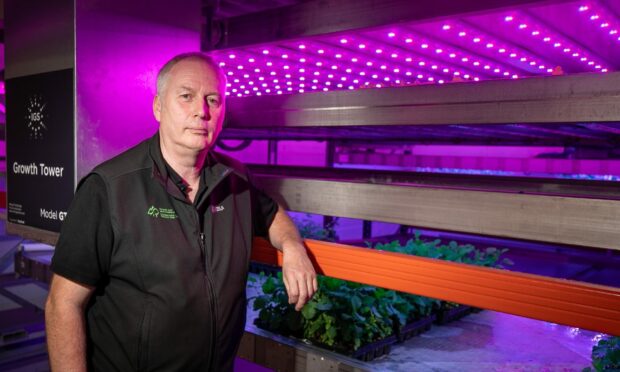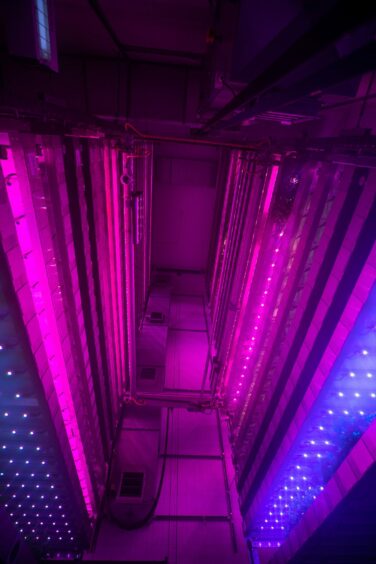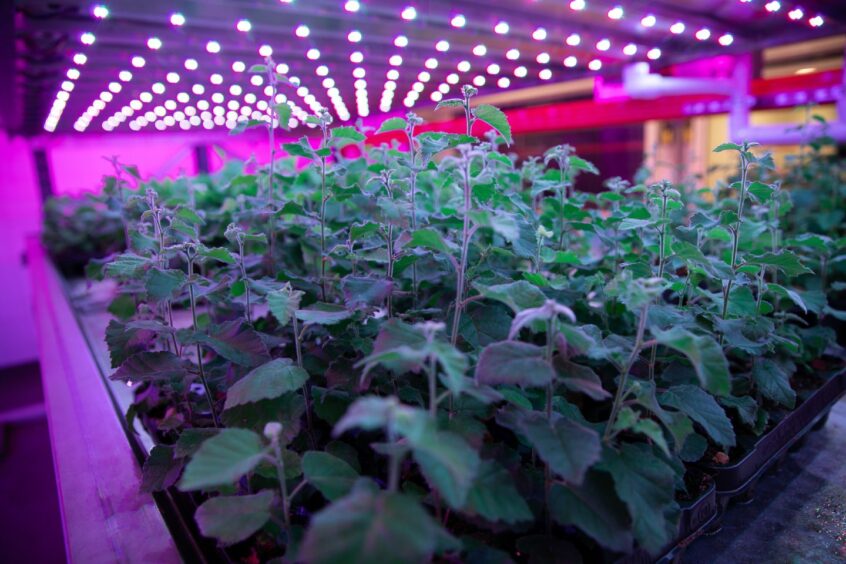A tree ‘vending machine’ being trialled in Invergrowrie could hold the key to making Scotland less reliant on timber imports.
Forestry and Land Scotland have been growing sapling trees in a vertical farming environment more usually associated with vegetables at Invergowrie’s Intelligent Growth Solutions (IGS).
Kenny Hay, who is the Forestry and Land Scotland’s tree nursery and seed resource manager, said: “It’s got a lot of potential.
“Planting more trees, both for timber and biodiversity benefits, is vital if we are to tackle the twin crisis of climate and biodiversity.”
Inside the tower
You would be forgiven for comparing the growing towers at the IGS Crop Research Centre, based at the James Hutton Institute, with something out of a science fiction movie.
Trees are grown under multicoloured lights in trays stacked nine metres high, and are watered by robotic technology.
And they grow at an unbelievable rate – broadleaf species such as oak can reach 50cm in 90 days.
Using traditional sowing methods, that amount of growth would take 18 months. This is six times faster.
‘Giant vending machine’
Dave Scott is co-founder and chief technology officer at IGS.
“Think of this as a giant vending machine, which is seven stories tall.
“Inside this vending machine we can totally control every aspect of what happens inside.”
The technology may be state-of-the-art, but its construction has a few surprises.
Dave says inspiration for the watering system came from a “kid’s water pistol”.
Hear Dave explain this in more detail in the video below.
Growing plants under these conditions takes a mixture of modern science and old fashioned ‘green-fingered knowledge’.
And the process involves a bit of trial and error.
The trays of little trees sunning themselves under red and blue LEDs are the trial’s sixth batch of saplings.
“The limitation just now is the understanding of how things grow,” says Dave.
“Every crop has a different response to the variables and levers we can pull.
“So what we’re doing here is investigating the different responses to all the things we can adjust.”
“On our first run we managed to grow trees at a height and yield that made sense for the industry. But they weren’t tough enough.
“So we changed the levers and we made the trees tough so when they went outside they were tough enough to survive.”
Could vertically farmed trees provide timber for housebuilding?
Scientists have discovered that growing trees in these conditions can yield seed germination rates as high as 95%.
And the team behind the trial have managed to grow both conifers and broadleaf species.
Kenny says sitka spruce, one of the species being grown in the trial, is used extensively in housebuilding.
The UK currently imports 80% of its timber.
“We are the second largest importer of timber by volume in the world, behind China.”
However, he adds that in order for Scotland to meet its own demands more landowners would have to embrace commercial forestry.
“So you’ve got to persuade landowners to come out of the particular land use they’re currently in.”
Need for renewable energy
Kenny says vertical farming offers many advantages.
“The main thing about a vertical farm is space.
“You’ve got a 300 square metre footprint with four towers nine metres high.
“We reckon we can grow between six and eight million trees here.
“The point is, it’s controllable. It uses so much less water, it uses no herbicide.”
But the process is “energy hungry”.
He adds: “That’s the negative.
“So we need to think about renewable energy.”
The equipment is also expensive.
“But if you can guarantee you’re getting renewable energy, it’s an absolute no-brainer.”
‘Whoosh’
The trays of saplings are the sixth batch to be grown at IGS.
Kenny says the first batch of broadleaf specimens went “whoosh” and they could not believe the rate of growth.
“They were actually getting burnt by the lights, they were growing so fast”.
Finding the right formula of light, heat and watering has been a learning curve for the team.
They are now trying to make the plants grow more slowly to see if that makes them fare better outdoors.
When asked if this technology could be used to reforest swathes of Scotland, Kenny replied “why not?”
Forestry and Land Scotland staff have already planted out seedlings at their Newton Nursery near Elgin, and the trees are doing well.
“This is absolutely in a trial stage. We’re trying to prove the concept first and foremost.”















Conversation